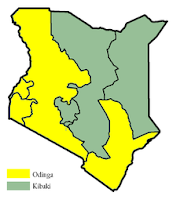 When the National
Rainbow Coalition split up into factions, Ralia Odinga became the leader of one
of the NARC groups and pushed for a new draft constitution in 2005 that would
increase the checks and balances in the administration. This constitution was never passed. Two years later, in the 2007 elections,
Odinga and Kalonzo Musyoka, who had also been a part of NARC, ran against
Kibaki, the incumbant. Odinga’s Orange
Democratic Movement (ODM) party “fell seven seats short of an absolute
majority. The presidential election, however, was seen by observers as deeply
flawed, with evidence of rigging on both sides.”[1] Kibaki was the supposed winner, and was sworn
in immediately. In the six weeks of
violent riots that followed the suspicious election, up to 500,000 people were
displaced and 1,300 were killed. In
2008, aid donors pressed for an agreement to divide power among the candidates
and to form a coalition government in Kenya, in which Odinga became the new prime
minister and Kibaki retained the presidential title. A new constitution was drafted. (See “2010 Constitution” section.)
When the National
Rainbow Coalition split up into factions, Ralia Odinga became the leader of one
of the NARC groups and pushed for a new draft constitution in 2005 that would
increase the checks and balances in the administration. This constitution was never passed. Two years later, in the 2007 elections,
Odinga and Kalonzo Musyoka, who had also been a part of NARC, ran against
Kibaki, the incumbant. Odinga’s Orange
Democratic Movement (ODM) party “fell seven seats short of an absolute
majority. The presidential election, however, was seen by observers as deeply
flawed, with evidence of rigging on both sides.”[1] Kibaki was the supposed winner, and was sworn
in immediately. In the six weeks of
violent riots that followed the suspicious election, up to 500,000 people were
displaced and 1,300 were killed. In
2008, aid donors pressed for an agreement to divide power among the candidates
and to form a coalition government in Kenya, in which Odinga became the new prime
minister and Kibaki retained the presidential title. A new constitution was drafted. (See “2010 Constitution” section.)
[1] Blanchard, Lauren Ploch. “Kenya: Current Issues and U.S. Policy.” Congressional Research Service Report for
Congress. February 26, 2013. Congressional Research Service. <http://www.fas.org/sgp/crs/row/R42967.pdf>. Accessed May 25, 2013.

No comments:
Post a Comment